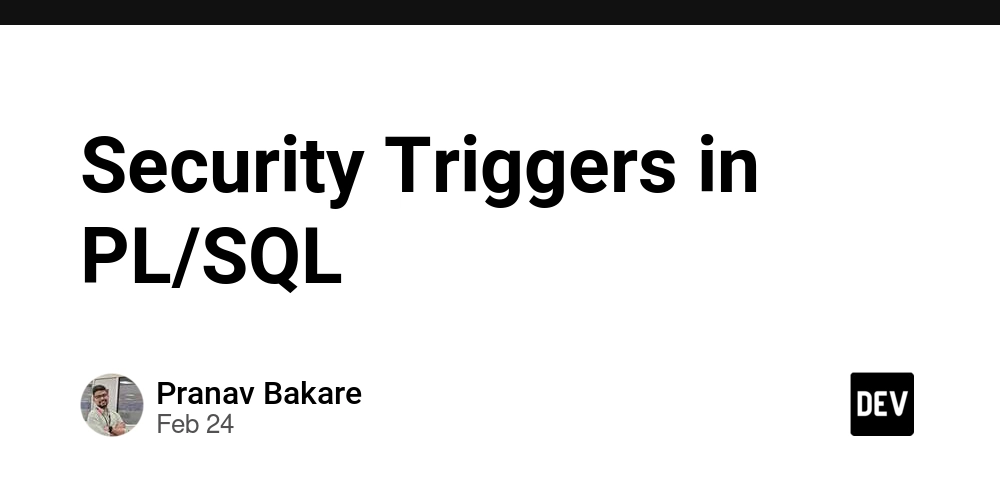Security Triggers in PL/SQL
When implementing security triggers in your PL/SQL, you should focus on the following three critical areas: Access Control & Restriction Prevent unauthorized users from modifying or deleting critical records. Ensure only specific roles can perform sensitive operations. Key Fields: USER (current database user) ROLE (user's assigned role) ACTION (INSERT, UPDATE, DELETE) Example: Prevent Non-Admin Users from Deleting Cargo Data CREATE OR REPLACE TRIGGER prevent_deletion BEFORE DELETE ON cargo_shipments FOR EACH ROW BEGIN IF USER NOT IN ('ADMIN_ROLE', 'DBA') THEN RAISE_APPLICATION_ERROR(-20002, 'Unauthorized deletion attempt detected.'); END IF; END; / Audit Logging for Compliance & Monitoring Track changes made to important tables. Maintain an audit trail for who, what, when of modifications. Key Fields: user_name (who made the change) operation_type (INSERT, UPDATE, DELETE) timestamp (when the change happened) Example: Log All Updates on Cargo Shipments CREATE OR REPLACE TRIGGER log_updates AFTER UPDATE ON cargo_shipments FOR EACH ROW BEGIN INSERT INTO audit_log (user_name, operation_type, table_name, timestamp) VALUES (USER, 'UPDATE', 'cargo_shipments', SYSTIMESTAMP); END; / Data Integrity & Business Rule Enforcement Ensure critical fields maintain integrity and comply with business rules. Prevent unauthorized updates to sensitive financial or customer data. Key Fields: OLD_VALUE (previous value) NEW_VALUE (updated value) condition_check (ensures valid changes) Example: Prevent Employees from Modifying Their Own Salary CREATE OR REPLACE TRIGGER prevent_salary_update BEFORE UPDATE ON employees FOR EACH ROW BEGIN IF :NEW.salary :OLD.salary AND USER = :OLD.employee_username THEN RAISE_APPLICATION_ERROR(-20003, 'You cannot modify your own salary.'); END IF; END; / Final Takeaway Whenever you're working with security triggers, make sure to implement at least: ✅ Access Control – Restrict actions based on user roles. ✅ Audit Logging – Track and log database modifications. ✅ Data Integrity Enforcement – Enforce business rules and prevent unauthorized modifications.

When implementing security triggers in your PL/SQL, you should focus on the following three critical areas:
- Access Control & Restriction
Prevent unauthorized users from modifying or deleting critical records.
Ensure only specific roles can perform sensitive operations.
Key Fields:
USER (current database user)
ROLE (user's assigned role)
ACTION (INSERT, UPDATE, DELETE)
Example: Prevent Non-Admin Users from Deleting Cargo Data
CREATE OR REPLACE TRIGGER prevent_deletion
BEFORE DELETE ON cargo_shipments
FOR EACH ROW
BEGIN
IF USER NOT IN ('ADMIN_ROLE', 'DBA') THEN
RAISE_APPLICATION_ERROR(-20002, 'Unauthorized deletion attempt detected.');
END IF;
END;
/
- Audit Logging for Compliance & Monitoring
Track changes made to important tables.
Maintain an audit trail for who, what, when of modifications.
Key Fields:
user_name (who made the change)
operation_type (INSERT, UPDATE, DELETE)
timestamp (when the change happened)
Example: Log All Updates on Cargo Shipments
CREATE OR REPLACE TRIGGER log_updates
AFTER UPDATE ON cargo_shipments
FOR EACH ROW
BEGIN
INSERT INTO audit_log (user_name, operation_type, table_name, timestamp)
VALUES (USER, 'UPDATE', 'cargo_shipments', SYSTIMESTAMP);
END;
/
- Data Integrity & Business Rule Enforcement
Ensure critical fields maintain integrity and comply with business rules.
Prevent unauthorized updates to sensitive financial or customer data.
Key Fields:
OLD_VALUE (previous value)
NEW_VALUE (updated value)
condition_check (ensures valid changes)
Example: Prevent Employees from Modifying Their Own Salary
CREATE OR REPLACE TRIGGER prevent_salary_update
BEFORE UPDATE ON employees
FOR EACH ROW
BEGIN
IF :NEW.salary <> :OLD.salary AND USER = :OLD.employee_username THEN
RAISE_APPLICATION_ERROR(-20003, 'You cannot modify your own salary.');
END IF;
END;
/
Final Takeaway
Whenever you're working with security triggers, make sure to implement at least:
✅ Access Control – Restrict actions based on user roles.
✅ Audit Logging – Track and log database modifications.
✅ Data Integrity Enforcement – Enforce business rules and prevent unauthorized modifications.











































































































































































![[The AI Show Episode 142]: ChatGPT’s New Image Generator, Studio Ghibli Craze and Backlash, Gemini 2.5, OpenAI Academy, 4o Updates, Vibe Marketing & xAI Acquires X](https://www.marketingaiinstitute.com/hubfs/ep%20142%20cover.png)




























































































































![[DEALS] The Premium Learn to Code Certification Bundle (97% off) & Other Deals Up To 98% Off – Offers End Soon!](https://www.javacodegeeks.com/wp-content/uploads/2012/12/jcg-logo.jpg)


![From drop-out to software architect with Jason Lengstorf [Podcast #167]](https://cdn.hashnode.com/res/hashnode/image/upload/v1743796461357/f3d19cd7-e6f5-4d7c-8bfc-eb974bc8da68.png?#)








































































































.png?#)























.webp?#)










_Christophe_Coat_Alamy.jpg?#)
 (1).webp?#)




































































































![Apple Considers Delaying Smart Home Hub Until 2026 [Gurman]](https://www.iclarified.com/images/news/96946/96946/96946-640.jpg)
![iPhone 17 Pro Won't Feature Two-Toned Back [Gurman]](https://www.iclarified.com/images/news/96944/96944/96944-640.jpg)
![Tariffs Threaten Apple's $999 iPhone Price Point in the U.S. [Gurman]](https://www.iclarified.com/images/news/96943/96943/96943-640.jpg)



































































































































